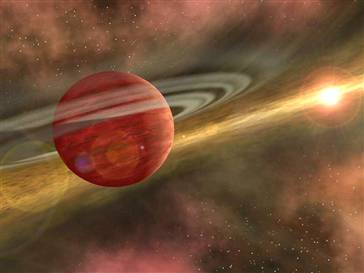Astronomers identify the youngest forming planet yet seen
 London, April 2: A team of astronomers has identified the youngest forming planet yet seen, which is just in its embryonic stage.
London, April 2: A team of astronomers has identified the youngest forming planet yet seen, which is just in its embryonic stage.
Led by Dr Jane Greaves of the University of St Andrews, the team used the Very Large Array (VLA) of radio telescopes in the US, to study the disk of gas and rocky particles around the star HL Tau.
This star is thought to be less than 100000 years old and lies in the direction of the constellation of Taurus at a distance of 520 light years.
The disk around HL Tau is unusually massive and bright, which makes it an excellent place to search for signs of forming planets.
The team studied the system using radio emission at a wavelength of 1.3 cm, specifically chosen to search for the emission from super-large rocky particles about the size of pebbles. The presence of these pebbles is a clue that rocky material is beginning to clump together to form planets.
In the UK, scientists used the MERLIN array of radio telescopes centred on Jodrell Bank in Cheshire, to study the same system at longer wavelengths. This allowed the astronomers to confirm that the emission is from rocks and not from other sources such as hot gas.
The big surprise was that, as well as detecting super-large dust in the disk around HL Tau, an extra bright ‘clump’ was seen in the image. It confirms tentative 'nebulosity' reported a few years earlier at around the same position.
According to Dr Greaves comments, “We see a distinct orbiting ball of gas and dust, which is exactly how a very young protoplanet should look. In the future, we would expect this to condense out into a gas giant planet like a massive version of Jupiter.”
“The protoplanet is about 14 times as massive as Jupiter and is about twice as far from HL Tau as Neptune is from our Sun,” he added.
“The new object, designated HL Tau b, is the youngest planetary object ever seen and is just 1 percent as old as the young planet found in orbit around the star TW Hydrae that made the news last year,” said Jodrell Bank scientist Dr Anita Richards.
“HL Tau b gives a unique view of how planets take shape, because the VLA image also shows the parent disk material from which it formed,” she added. (ANI)